Maintaining a sparkling clean swimming pool can be a chore, but the advent of garden hose pool vacuums has made the task significantly easier. These devices, utilizing the readily available power of a garden hose, offer a cost-effective and convenient solution for pool owners. Enjoy a sparkling clean pool without the hassle of traditional vacuuming methods.
Why use a garden hose pool vacuum?
Using a garden hose pool vacuum can offer several advantages over traditional pool cleaners, particularly in terms of cost-effectiveness, simplicity, and environmentally friendly operation.
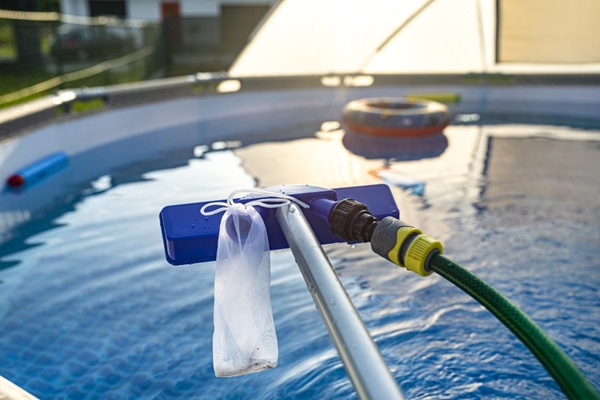
The benefits of water-powered pool vacuums
Here are some of the of the benefits of water-powered pool vacuums:
Cost-Effectiveness: Garden hose pool vacuums are generally more affordable than electric or battery-powered pool cleaners. They don’t require additional energy sources, which can lead to long-term cost savings.
Simplicity: Water-powered pool vacuums are typically easy to set up and operate. They require minimal setup and connect directly to your garden hose for power, making them user-friendly for pool owners of all experience levels.
Environmentally Friendly: Since water-powered pool vacuums operate solely on the pressure of water from a garden hose, they don’t consume electricity or produce emissions, making them environmentally sustainable options for pool cleaning.
Versatility: Water-powered pool vacuums are versatile and can be used for various pool types, including vinyl and above-ground pools. They can effectively clean both the pool floor and walls, removing dirt, debris, and algae buildup.
Comparing traditional pool cleaners with garden hose-powered models
| Feature | Traditional Cleaners | Garden Hose-Powered |
| Power Source | Pool’s pump or electricity | Water pressure from a garden hose |
| Automation | Mostly automatic (robotic) or semi-automatic (pressure-side) | Manual operation is required. |
| Cleaning Coverage | Floors, walls, and waterline (depending on model) | Primarily floors, some models might reach halfway up walls. |
| Suction Power | Generally, stronger suction | Suction power can be moderate. |
| Setup | Requires connection to the pool’s plumbing system or electrical outlet. | Simple setup, connects directly to garden hose |
| Maintenance | May require emptying filter bags or baskets. | Requires emptying the debris canister regularly. |
| Cost | Generally more expensive | The most affordable option |
| Suitability | Ideal for in-ground pools of all sizes, good for heavy debris loads | Ideal for above-ground pools or quick cleanups on in-ground pools, it works best for light to moderate debris. |
Is a water-powered pool vacuum safe for vinyl and above-ground pools?
Yes, water-powered pool vacuums are generally safe for vinyl and above-ground pools when used correctly and according to the manufacturer’s instructions. However, it’s essential to ensure that the vacuum’s suction power is appropriate for the specific type of pool to avoid damaging the vinyl liner or above-ground pool walls.
Here are some considerations to keep in mind to ensure the safe use of a water-powered pool vacuum in vinyl and above-ground pools:
1. Suction Power: Adjust the water flow or suction power of the vacuum to a level that is suitable for the pool’s surface material. Vinyl liners, in particular, are more susceptible to damage from high suction power or abrasive cleaning tools. Most water-powered pool vacuums allow for adjustment of the water flow to accommodate different pool types.
2. Inspect for Damage: Before using the pool vacuum, carefully inspect the pool’s surface for any tears, punctures, or weak spots in the vinyl liner. Avoid using the vacuum in areas where the vinyl is damaged, as the suction could worsen the problem or cause further tearing.
3. Avoid Sharp Objects: Be mindful of any sharp or abrasive debris that may be present on the pool floor or walls, especially in above-ground pools where the pool walls are often made of softer materials. Avoid using the vacuum in areas with sharp objects to prevent puncturing the vinyl liner or damaging the pool walls.
4. Follow Manufacturer Guidelines: Always follow the manufacturer’s instructions and recommendations for safe operation of the water-powered pool vacuum. This includes proper setup, usage, and maintenance procedures to ensure the vacuum performs effectively and safely.
5. Regular Maintenance: Keep the pool vacuum clean and well-maintained to prevent debris buildup or clogs that could affect its performance. Inspect the vacuum regularly for any signs of damage or wear, and replace any worn-out parts as needed.
Choosing the right pool vacuum for your swimming pool
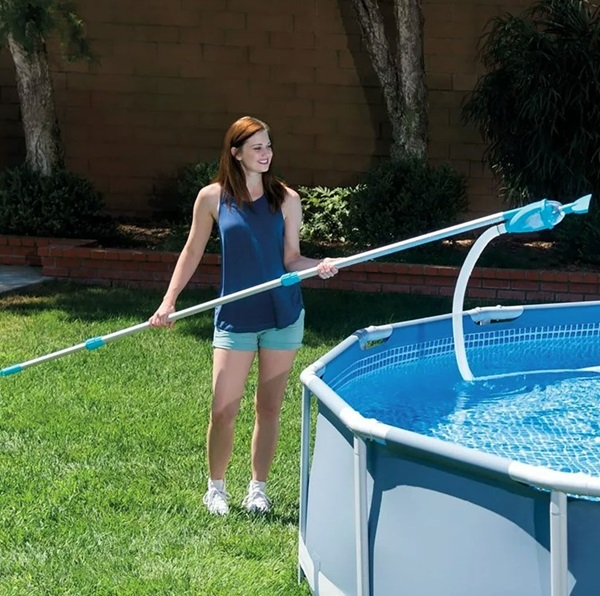
Choosing the right pool vacuum for your swimming pool involves considering factors such as pool type (inground or above-ground), size, shape, surface material, and personal preferences.
Here’s a guide to finding the perfect fit for both inground and above-ground pools, along with features to look for in a garden hose pool vacuum and the role of suction and water pressure in pool cleaning efficiency:
Finding the perfect fit for inground and above-ground pools
- Inground Pools: For inground pools, you’ll want a pool vacuum that can effectively clean the pool floor, walls, and possibly stairs or other features. Look for models with adjustable suction power and brushes designed for various surface materials.
- Above-Ground Pools: Above-ground pools typically have softer walls and may require a gentler cleaning approach to avoid damage to the pool liner. Choose a pool vacuum specifically designed for above-ground pools, with features like soft brushes and adjustable suction settings.
Features to look for in a garden hose pool vacuum
- Adjustable Suction Power: This allows you to control the strength of the vacuum, making it suitable for different pool surfaces and debris types.
- Maneuverability: Look for a vacuum with swivel wheels or an easy-glide design for smooth movement around the pool.
- Versatility: Choose a vacuum that can clean both the pool floor and walls, offering comprehensive cleaning coverage.
- Durability: Opt for a well-built vacuum with sturdy construction and quality materials to ensure longevity.
- Ease of Use: Consider factors such as setup, operation, and maintenance requirements to find a vacuum that fits your preferences and skill level.
The role of suction and water pressure in pool cleaning efficiency
- Suction Power: Suction is crucial for lifting and removing debris from the pool surface. Too much suction can be damaging, especially to vinyl liners or soft pool walls, so adjustable suction settings are beneficial.
- Water Pressure: Water pressure from the garden hose powers the vacuum and creates suction. Higher water pressure can result in stronger suction but may also lead to increased water usage. Balancing water pressure with suction power is key to efficient cleaning without wasting water.
When choosing a pool vacuum, it’s essential to consider how well it aligns with your pool’s specific requirements and your cleaning preferences. Whether you have an in-ground or above-ground pool, selecting a vacuum with the right features and capabilities will help keep your pool clean and well-maintained throughout the swimming season.
How to set up your garden hose pool vacuum
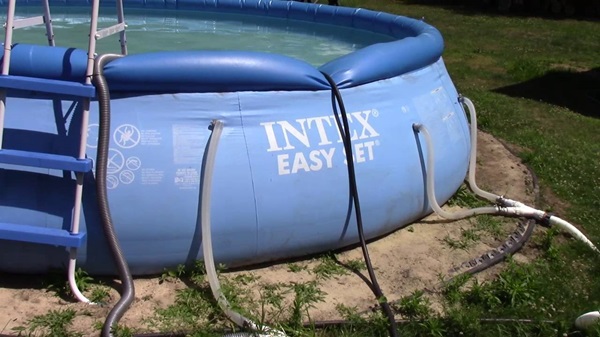
Step-by-step guide to connecting your vacuum to a garden hose
Setting up a garden hose pool vacuum is typically straightforward and can be done with just a few simple steps. Here’s a step-by-step guide to connecting your vacuum to a garden hose:
Step 1: Gather Your Equipment:
Gather all the necessary equipment, including the garden hose, pool vacuum, and garden hose.
Step 2: Check the Vacuum Components:
Before you begin, ensure that all the components of your garden hose pool vacuum are present and in good condition. This includes the vacuum head, vacuum handle, or pole, and any attachments or accessories that may be included.
Step 3: Attach the garden hose.
Locate the inlet port on the garden hose pool vacuum. This is where you will connect the garden hose.
- If the vacuum has a threaded inlet port, simply screw the garden hose onto the port until it is securely attached.
- If the vacuum has a snap-on or push-fit inlet port, press the end of the garden hose firmly onto the port until it snaps into place.
Step 4: Ensure a Tight Seal
Once the garden hose is attached, ensure that there is a tight seal between the hose and the vacuum’s inlet port. This will prevent water from leaking out and ensure that the vacuum operates efficiently.
Step 5: Turn on the water
With the garden hose securely attached to the vacuum, turn on the water supply. This will provide the water pressure necessary to power the vacuum.
Step 6: Prime the Vacuum (if necessary)
Some garden hose pool vacuums may require priming to remove air from the system and ensure proper suction. Follow the manufacturer’s instructions for priming, which may involve filling the vacuum with water before connecting it to the hose.
Step 7: Begin Cleaning
Once the vacuum is connected and the water is flowing, lower the vacuum head into the pool. Ensure that the vacuum head makes full contact with the pool surface. Move the vacuum around the pool in a systematic pattern, covering the entire pool floor and walls as needed.
Step 8: Adjust Suction (if possible):
If your garden hose pool vacuum has adjustable suction settings, you may need to adjust them to achieve the desired cleaning power. Follow the manufacturer’s instructions for adjusting suction settings.
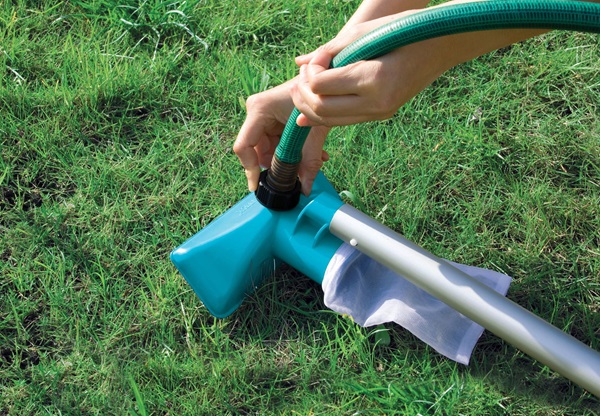
Adjusting the suction power for effective pool cleaning
While the exact methods for adjusting suction power will vary depending on your specific garden hose pool vacuum model, here’s a general guide to help you achieve effective cleaning:
Factors Affecting Suction Power:
- Water Pressure: The primary factor influencing suction power is the water pressure coming from your garden hose. Higher water pressure translates to stronger suction.
Vacuum Design: Some models might have a built-in adjustment valve near the handle that allows you to regulate suction to a certain extent.
Optimizing Suction for Cleaning:
- Start with high water pressure: Turn on your hose fully for maximum water pressure. This provides the strongest initial suction for picking up debris.
Observe Vacuum Performance: See how the vacuum performs at full pressure. If it struggles to move or maintain suction, debris might be clogging the hose or filter bag. Address any clogs before proceeding.
Adjust valve (if available): If your model has a suction adjustment valve, try slightly reducing the water flow by turning down the valve a notch or two. This can be helpful in the following scenarios:
Debris Size: For very fine debris like sand, a slightly lower suction might be more effective to avoid clogging the filter bag and allow for better collection.
Pool Surface: For delicate pool surfaces like vinyl liners, a gentler suction can help prevent scratches.
Monitoring and fine-tuning:
- Maneuverability: The vacuum should move smoothly across the pool floor with enough suction to pick up debris. If it’s difficult to maneuver, reduce the suction slightly.
- Debris Collection: Pay attention to how well the vacuum collects debris. If it’s not picking things up effectively, try increasing the suction power.
- Filter Bag Clogging: Keep an eye on the filter bag and empty it regularly to prevent clogging, which can significantly reduce suction power.
Essential accessories: hose adapter, filter bag, and pool pole
Essential accessories can enhance the functionality and efficiency of your pool vacuum, ensuring effective cleaning and ease of use. Here are three essential accessories commonly used with pool vacuums:
1. Hose Adapter:
A hose adapter is a connector that allows you to attach your pool vacuum hose to different types of vacuum heads or inlet ports. It ensures a secure and watertight connection, preventing leaks and optimizing suction power. Hose adapters come in various sizes and configurations to fit different vacuum models and hose types.
2. Filter Bag:
A filter bag is an essential accessory for pool vacuums that helps trap and collect debris, preventing it from entering your pool’s filtration system. Filter bags are typically made of fine mesh or fabric material that captures small particles, leaves, and other debris while allowing water to pass through. Regularly cleaning or replacing the filter bag ensures optimal filtration and cleaning performance.
3. Pool Pole:
A pool pole, also known as a telescopic pole or vacuum pole, is a long, adjustable pole used to maneuver and control the pool vacuum head during cleaning. It allows you to reach different areas of the pool, including the floor, walls, and waterline, without having to enter the water yourself. Pool poles come in various lengths and materials, such as aluminum or fiberglass, and often feature a universal attachment point for connecting to vacuum heads, brushes, or other pool maintenance accessories.
Maintaining and cleaning your pool vacuum for longevity
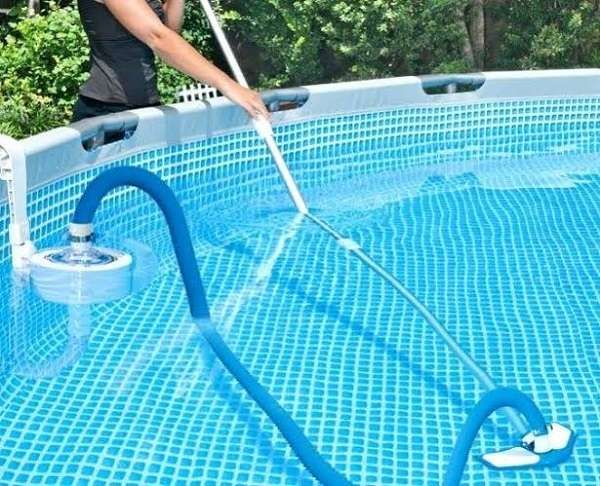
Cleaning and storage tips to keep your pool vacuum in top shape
Here are some maintenance tips, cleaning guidelines, and troubleshooting advice to keep your pool vacuum in top shape:
1. Regular Maintenance:
- Inspect your pool vacuum regularly for any signs of damage, wear, or clogs. Addressing minor issues promptly can prevent them from escalating into more significant problems.
- Check the vacuum’s hoses, connectors, and attachments for cracks, leaks, or blockages. Clean or replace any damaged components as needed.
- Keep the vacuum head and brush bristles clean and free of debris to maintain effective cleaning performance.
- Lubricate moving parts, such as swivel joints or wheels, to ensure smooth operation and prevent friction-related wear.
2. Cleaning and Storage Tips:
- After each use, rinse the pool vacuum thoroughly with clean water to remove any debris, dirt, or chemicals that may accumulate during cleaning.
- If your pool vacuum has a filter bag, empty and clean it regularly to prevent clogs and maintain optimal filtration. Follow the manufacturer’s instructions for cleaning or replacing the filter bag as needed.
- Store your pool vacuum in a dry, protected area away from direct sunlight and extreme temperatures. Proper storage helps prevent damage and prolongs the life of your vacuum.
When to replace your pool vacuum’s filter bag and other accessories
- Monitor the condition of your pool vacuum’s filter bag and other accessories regularly. Replace the filter bag if it becomes torn, worn out, or clogged beyond cleaning.
- Consider replacing other accessories, such as hoses, connectors, or brushes, if they show signs of damage, deterioration, or reduced effectiveness.
Troubleshooting common issues with garden hose pool vacuums
- Low Suction: Check for clogs or blockages in the vacuum hoses, connectors, or filter bag. Clean or remove any obstructions to restore proper suction.
- Stuck Vacuum Head: If the vacuum head becomes stuck to the pool floor or walls, reduce the suction power or adjust the vacuum’s position to release it.
- Leaks: Inspect the vacuum hoses, connectors, and seals for any signs of damage or leaks. Tighten connections or replace damaged components to prevent leaks.
Unique features of top garden hose pool vacuums in 2024
In 2024, top garden hose pool vacuums will continue to innovate with unique features aimed at enhancing cleaning efficiency, convenience, and user experience.

Spotlight on the Poolmaster, Intex, and Black Magic models
Here’s a spotlight on some notable models from Poolmaster, Intex, and Black Magic, along with innovations in pool cleaning and the future of pool maintenance:
1. Poolmaster:
Poolmaster offers a range of garden hose pool vacuums known for their durability and effectiveness in cleaning various pool surfaces. Some unique features of Poolmaster vacuums may include:
- Advanced suction technology for efficient debris removal.
- Adjustable suction power settings to accommodate different pool types and cleaning needs.
- Innovative brush designs for enhanced scrubbing and debris loosening.
2. Intex:
Intex is known for its affordable and user-friendly pool products, including garden hose pool vacuums. Unique features of Intex vacuums may include:
- Lightweight and portable designs for easy maneuverability and storage.
- Quick-connect fittings for hassle-free attachment to standard garden hoses.
- Multi-functional attachments for versatile cleaning capabilities, such as vacuuming, skimming, and brushing.
3. Black Magic:
Black Magic specializes in innovative pool cleaning solutions designed to make maintenance easier and more efficient. Unique features of Black Magic vacuums may include:
- Jet vacuum technology for powerful and targeted suction is ideal for removing stubborn debris and algae.
- Ergonomic designs with comfortable grips and intuitive controls for effortless operation.
- Heavy-duty construction for durability and long-lasting performance.
Innovations in pool cleaning: jet vacuums and portable pool cleaners
Jet Vacuums: Jet vacuum technology utilizes high-pressure water jets to dislodge and suction debris from pool surfaces effectively. These vacuums offer superior cleaning power and are particularly effective for removing algae and other tough stains.
Portable Pool Cleaners: Portable pool cleaners are compact and lightweight devices that provide on-the-go cleaning for small pools, spas, or hot tubs. These cleaners are powered by rechargeable batteries or water pressure from a garden hose, offering convenience and versatility for quick maintenance tasks.
The future of pool maintenance: exploring new pool vacuum technology
Advanced Automation: Future pool vacuums may incorporate advanced automation features, such as robotic navigation systems and remote control capabilities, for hands-free cleaning and customizable cleaning schedules.
Smart Integration: Pool vacuums may integrate with smart home systems and mobile apps, allowing users to monitor and control cleaning tasks remotely and receive real-time alerts and notifications.
Enhanced Efficiency: Future pool vacuum technology may focus on improving energy efficiency, water conservation, and cleaning performance to minimize environmental impact and operating costs.
As technology continues to evolve, the future of pool maintenance holds exciting possibilities for more efficient, convenient, and sustainable cleaning solutions. Manufacturers are likely to continue innovating to meet the evolving needs and preferences of pool owners worldwide.
Effective pool cleaning techniques using your garden hose pool vacuum
Effectively cleaning your pool with a garden hose pool vacuum involves a combination of techniques and tools to tackle different types of dirt, debris, and grime.
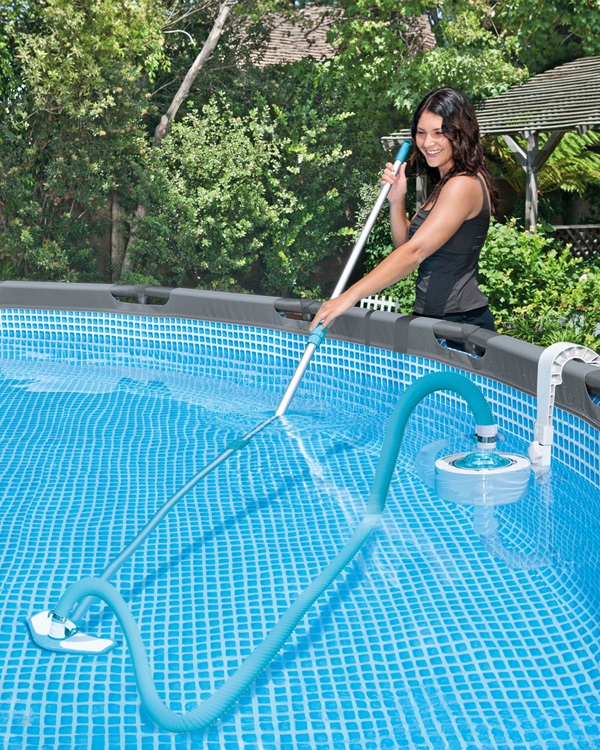
Strategies for tackling stubborn pool floor and wall grime
– Start by brushing the pool walls and floor to loosen any stubborn grime, algae, or buildup. Use a pool brush with stiff bristles to scrub away dirt and algae growth effectively.
– Target areas with visible stains or algae growth by concentrating the vacuum’s suction power on those spots. Move the vacuum head slowly over the affected areas to ensure a thorough cleaning.
– For particularly stubborn grime or algae, consider using a specialized pool cleaner or algaecide treatment in conjunction with your garden hose pool vacuum. Follow the manufacturer’s instructions carefully for the best results.
Maximizing your garden hose vacuum’s potential with a pool brush and skimmer
– Use a pool brush to agitate and loosen debris on the pool surface and walls before vacuuming. This helps enhance the vacuum’s cleaning effectiveness by preparing the surface for suction.
– Utilize a pool skimmer or leaf net to remove large debris, such as leaves, twigs, and insects, from the pool surface before vacuuming. This prevents clogs and ensures that the vacuum can focus on finer particles and sediment.
Seasonal pool maintenance tips to prevent algae and leaf buildup
– Regularly inspect and clean your pool’s filtration system, including skimmer baskets and filter cartridges, to ensure optimal efficiency and water circulation.
– Monitor and maintain proper water chemistry levels, including pH, chlorine, alkalinity, and calcium hardness, to prevent algae growth and maintain water clarity.
– Implement a routine pool maintenance schedule that includes vacuuming, brushing, skimming, and chemical treatment as needed. Adjust the frequency of cleaning tasks based on factors such as weather conditions, bather load, and foliage around the pool.
– Consider using a pool cover when the pool is not in use to minimize debris accumulation and reduce the need for frequent cleaning.
By incorporating these effective pool cleaning techniques and maintenance strategies into your routine, you can keep your pool clean, clear, and inviting throughout the swimming season while minimizing the risk of algae and leaf buildup. Regular attention to cleaning and maintenance ensures a safe and enjoyable swimming environment for you and your family.

Meet David Thomas, a seasoned professional with nearly 8 years of experience specializing in inspecting and resolving issues related to swimming pools. With his expertise and meticulous attention to detail, David ensures the safety and functionality of pools, making them a refreshing oasis for all to enjoy. Whether it’s troubleshooting equipment or maintaining water quality, David’s proficiency guarantees top-notch solutions tailored to meet every pool owner’s needs.
